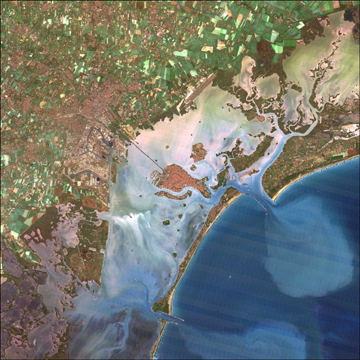
A new take on an old idea may save Venice yet from being swallowed by the sea.
In the Dec. 9 Eos, Giuseppe Gambolati and colleagues at the University
of Padua in Italy propose the injection of seawater or carbon dioxide deep into
the aquifer beneath Venice to essentially pump up the famed city.
 According
to the researchers, Venice has experienced a 23-centimeter relative rise in
sea level over the past century and now floods close to 100 times per year.
Although Venice has been sinking for hundreds of years, over the past century
the issue has been exacerbated by two factors: subsidence due to excessive groundwater
withdrawal and sea-level rise caused by global climate change.
According
to the researchers, Venice has experienced a 23-centimeter relative rise in
sea level over the past century and now floods close to 100 times per year.
Although Venice has been sinking for hundreds of years, over the past century
the issue has been exacerbated by two factors: subsidence due to excessive groundwater
withdrawal and sea-level rise caused by global climate change.
So far, the only comprehensive
plan for saving Venice that has gained the government’s approval and funding
is the MOSE project. Begun in May 2003, MOSE consists of a series of 79 mobile
barriers that will rest on the bottom of Venice’s three main inlets and
will close when tide waters reach above 110 centimeters above the reference
sea level (sea level in 1897), preventing storm surges from the Adriatic Sea
from entering the lagoon and flooding the city. The 8-year project will cost
an estimated 3 billion euros.
But, as reported in the Eos paper, some opponents worry that MOSE is
not enough to protect Venice. The opponents also worry that MOSE could endanger
the lagoon ecosystem by eliminating natural water circulation when the gates
close. Furthermore, the critics note that with a potential global sea-level
rise between 9 and 88 centimeters over the next century, according to some predictions,
the expensive project would be obsolete.
The Venice lagoon, as viewed from a NASA Landsat satellite 22,000 miles above Earth, is under threat from rising sea levels. One project is already underway to try to protect the ancient city, and other plans — such as seawater or carbon dioxide injection — are also being presented.
Thus, Gambolati and colleagues propose injection, a solution they say “can
complement MOSE in duration, safety and frequency of use, and suffers no measurable
environmental impact.”
The idea of injecting seawater into the aquifer was first proposed in the 1970s,
but was considered unfeasible at the time. Now, Gambolati’s team says that
new hydrogeological and geomechanical data plugged into models show that injection
can indeed work, “neutralizing almost all of the high tides.”
Venice is built on a group of low-lying islands in a lagoon that is joined to
the Adriatic Sea by three major inlets. The city lies atop 1,000 meters of poorly
consolidated sands, silts and clays. The brackish and sandy aquifer, 600 to
800 meters below the lagoon, is confined by a 25-meter-thick rock cap.
Gambolati and colleagues contend that uniformly injecting either carbon dioxide
or seawater into the aquifer would swell the underlying rocks, thus raising
the city between 12 and 30 centimeters. Using carbon dioxide produced by nearby
thermal power plants could also help Italy meet its carbon dioxide emissions
reduction goal. However, Gambolati says, the injection of seawater is much more
likely because it is cheaper, easier and will produce the maximum citywide uplift.
With a 30-centimeter uplift, the researchers say that according to models, only
11 floods above the 110-centimeter mark would have occurred since 1910 —
a 94-percent elimination of the “acqua alta,” or high-water floods
— which would reduce the necessary use of MOSE and eliminate some of the
environmental concerns.
“If it is technically feasible, it can be a good idea, complementary to
other projects to save Venice from sea-level rise and flooding,” says Paolo
Pirazzoli of the National Center for Scientific Research in France. Pirazzoli
has been involved in the scientific efforts to save Venice for years, and suggests
raising Venetian street levels or decreasing the inlet water depth to reduce
the flooding.
However, Rafael Bras, a hydrologist at MIT who is affiliated with MOSE, says
that because Gambolati’s injection theory is based on models of the subsurface,
which cannot capture the complex geology beneath Venice, “to argue that
you could engineer a controlled lifting of a whole city … is really pushing
it.” Bras, who says the arguments against MOSE are erroneous, stresses
that the only way to protect Venice and the rest of the region is to separate
the Adriatic from the lagoon during floods.
Gambolati recognizes that before his theory can become a reality, further subsurface
study is needed. CORILA, a consortium of universities charged with coordinating
research activities in the Venetian lagoon, is working with the University of
Padua to devise a pilot project for injection, which will take roughly three
to four years to complete, Gambolati says.
Megan Sever
Links:
CORILA
Research Program
Back to top
 |
Geotimes Home | AGI Home | Information Services | Geoscience Education | Public Policy | Programs | Publications | Careers |